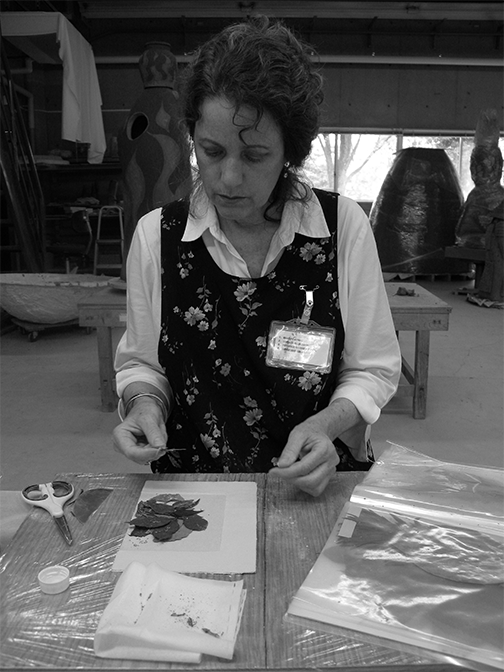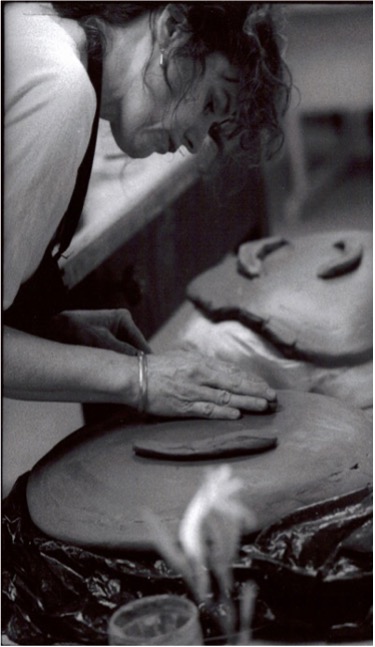
Katherine Sandnas is an internationally-recognized ceramic artist. An impressive and reserved woman, she is a remarkable blend of cross-cultural and historical experiences.
Integrity and purpose guide Katherine in her endeavors, whether she’s creating artwork, teaching a class, or preparing a meal. Born in southern Minnesota in the early 1950s, she began her relationship with the visual arts at an early age, experimenting in many mediums, and later found her passion was working with clay. Katherine's steadfast commitment to the ceramic arts and art education established her as an important artist and arts advocate.
Katherine's artistic vision is often described as a unique blending of cultural influences of American and Japanese prehistoric ceramics. Her powerful sculptural works are compelling female figures, imbued with her particular devotion to the feminine condition and express the beautiful, sacred,and enigmatic qualities of being a woman. The artworks are glaze-free in an almost casual manner, both primal and organic in nature. Her work is imbued with subdued and earthy colors. Primitive figures, vessels, and platters are her signature pieces. Katherine's artistic expression continues to grow with her life experiences. The incredible body of work Katherine has created also includes relief artworks and sculptures in bronze and iron. Katherine's works are exhibited in American and Asian museums and institutions.
Her education began at Hibbing Community College (Hibbing, Minnesota), with seminal Art Instructor William Goodman, a mentor and powerful influence. Goodman received his MFA at the University of Wisconsin-Madison; ceramics is only one of his specialties. Katherine completed her Bachelor’s degree at the University of Minnesota-Duluth. During graduate school at the University of Wisconsin-Superior, Katherine received a fellowship to study in Japan. This opportunity enabled her to encounter and study Japanese art, as well as visit master ceramists, ancient firing sites, museums, and galleries. In pursuit of her MFA, Katherine studied at the University of North Dakota-Grand Forks. During this time, she received a McKnight Fellowship to return to Japan for an artist residency at the Shigaraki Ceramic Cultural Park, where she studied, worked, and exhibited.
Left: Katherine & work in progress at the Shigaraki Ceramic Cultural Park, Shiga, Japan, 2013. Photograph by The Shigaraki Cultural Park.
Integrity and purpose guide Katherine in her endeavors, whether she’s creating artwork, teaching a class, or preparing a meal. Born in southern Minnesota in the early 1950s, she began her relationship with the visual arts at an early age, experimenting in many mediums, and later found her passion was working with clay. Katherine's steadfast commitment to the ceramic arts and art education established her as an important artist and arts advocate.
Katherine's artistic vision is often described as a unique blending of cultural influences of American and Japanese prehistoric ceramics. Her powerful sculptural works are compelling female figures, imbued with her particular devotion to the feminine condition and express the beautiful, sacred,and enigmatic qualities of being a woman. The artworks are glaze-free in an almost casual manner, both primal and organic in nature. Her work is imbued with subdued and earthy colors. Primitive figures, vessels, and platters are her signature pieces. Katherine's artistic expression continues to grow with her life experiences. The incredible body of work Katherine has created also includes relief artworks and sculptures in bronze and iron. Katherine's works are exhibited in American and Asian museums and institutions.
Her education began at Hibbing Community College (Hibbing, Minnesota), with seminal Art Instructor William Goodman, a mentor and powerful influence. Goodman received his MFA at the University of Wisconsin-Madison; ceramics is only one of his specialties. Katherine completed her Bachelor’s degree at the University of Minnesota-Duluth. During graduate school at the University of Wisconsin-Superior, Katherine received a fellowship to study in Japan. This opportunity enabled her to encounter and study Japanese art, as well as visit master ceramists, ancient firing sites, museums, and galleries. In pursuit of her MFA, Katherine studied at the University of North Dakota-Grand Forks. During this time, she received a McKnight Fellowship to return to Japan for an artist residency at the Shigaraki Ceramic Cultural Park, where she studied, worked, and exhibited.
Left: Katherine & work in progress at the Shigaraki Ceramic Cultural Park, Shiga, Japan, 2013. Photograph by The Shigaraki Cultural Park.

